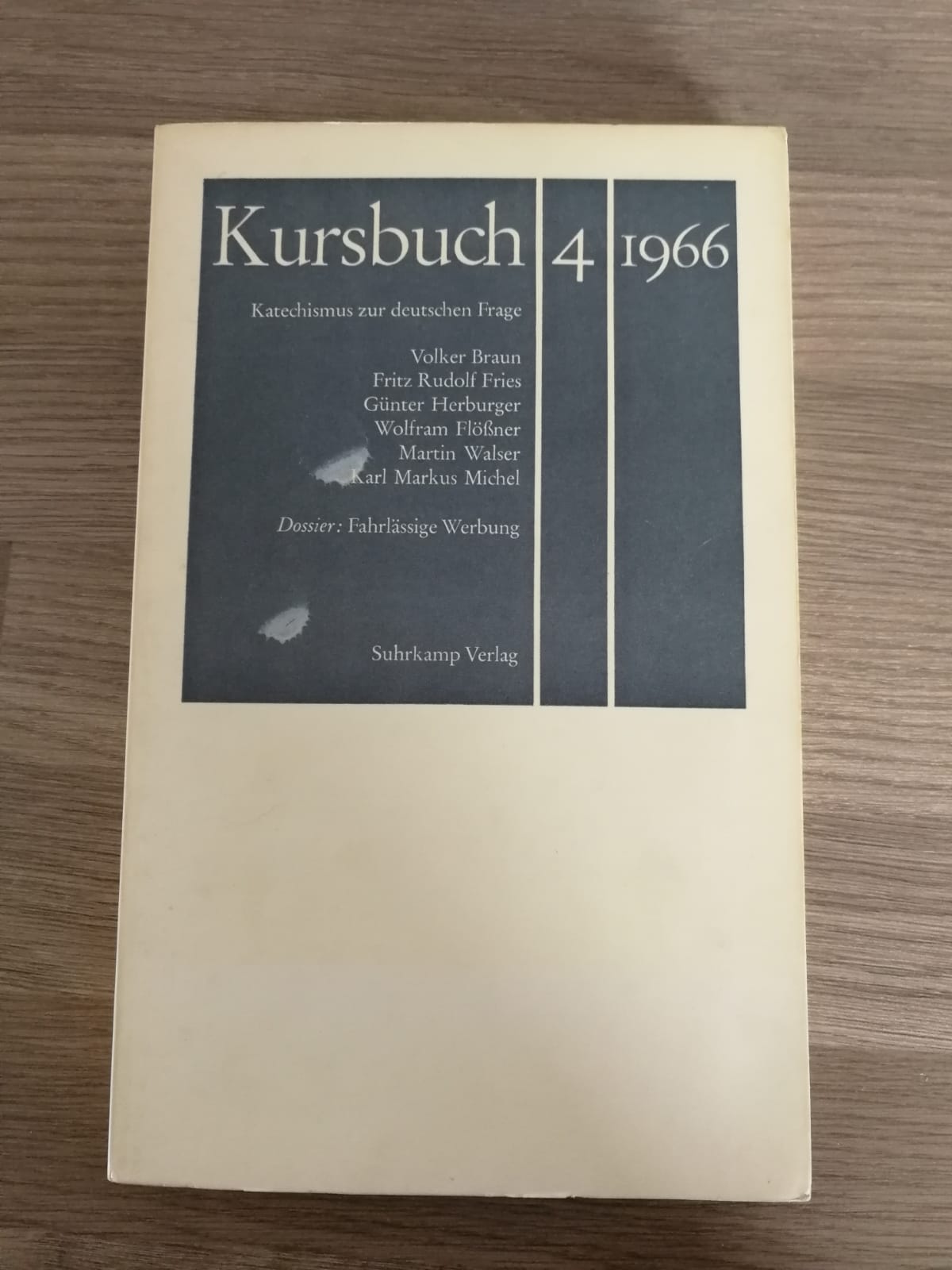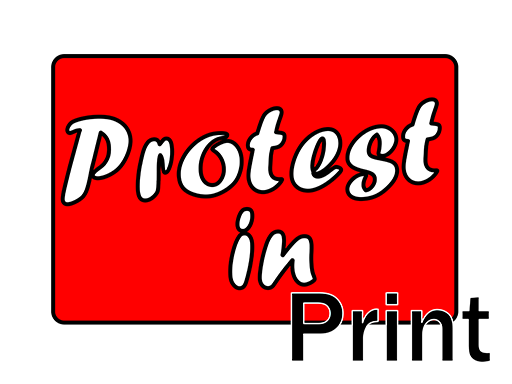Klau mich (Nick me), a paperback book produced in 1968, is an artwork made collaboratively by members of Germany’s first political commune, known as Kommune I (Commune I). In May 1967, commune members had created and distributed a series of provocative flyers in response to a recent fire in a Brussels department store that had received widespread press coverage. These flyers played with suggestions in the media that the fire had been started by arsonists, and seem to encourage West Berliners to carry out similar attacks. Yet these flyers were satirical works, intended to expose the double standards of the media and public opinion, and the language they used was at times playful and poetic. Commune member Fritz Teufel commented on the flyers, ‘We really wanted to trigger moral indignation in those people who are never outraged when they read about Vietnam or other bad things in their morning paper.’ (Translation by Puw Davies; see Puw Davies, Writing the West German Protest Movements, London, 2016, p. 116.)
The West German authorities did not recognise the satirical nature of these texts, however, and two members of the commune, Fritz Teufel and Rainer Langhans, were put on trial for incitement to arson in July 1967. They were acquitted on 22 March 1968, as as it could not be proven that they had intended to incite others to arson. Puw Davies sums up the trial in this way: ‘For sympathetic readers at the time, the communards’ achievement in West Berlin was not to have started real fires, but to have made a mockery of the West Berlin authorities’ (Writing the West German Protest Movements, p. 119). Each left-hand page of Klau mich records events from the trial in the form of a transcript, whilst the right-hand pages show a more random variety of artistic responses to the trial, to the media coverage of the Commune 1, and to other contemporary events.
Rainer Langhans and Fritz Teufel, Klau Mich (edition Voltaire, 1968)
Left hand page: This is part of a bill of indictment dated 27th November 1967, against those members of Commune 1 who distributed the flyers relating to the Brussels department store fire on May 24th. The page shown here lists other offences committed (with dates) by Dieter Kunzelmann, and Volker Gebbert.
The offence committed by Dieter Kunzelmann on 6. 10 1967 translates as:
‘Disrupted the Rathenau Ceremony in the grand auditorium of the FU [Freie Universität], during a speech made by Foreign Secretary Brandt.’
The offence committed by Dieter Kunzelmann on 21. 10 1967 translates as:
‘Participated in a Vietnam Demonstration on Wittenburgplatz, instigated by the distribution of so-called ‘Vietnam-Information.’ Following this, caused disruption on the Kurfürstendamm.’
Images © British Library Board (270/4358 DSC)

Right-hand page: ‘Crossword puzzle for Advanced Players – read first, solve later! See next page for questions.’
Beneath the main crossword puzzle is a free-standing ‘Extra Puzzle,’ with the following clue:
‘1) First name of a Politician, who refused to believe the warnings of
2) a well-known astronomer from Hamburg, and who was nearly shot as a result.’
Left hand page: This section of the trial describes the disruption caused by ‘radical groups’ of activists in West Berlin department stores on 26th August 1967, when many stores had extended opening hours. Two incidents in particular are mentioned:
‘a) There was an incident involving two protestors in KaDeWe [Kaufhaus des Westens], as they lit cigarettes whilst standing in the immediate proximity of highly flammable products. Having ignored frequent requests by security personnel to put out their cigarettes, the burning ends of their cigarettes had to be forcibly cut off, in order to comply with security regulations.’
‘b) Sales personnel in DeFaKa [Deutsches Familien Kaufhaus] were threatened by one protester, who warned them that “a bomb would go off” if sales were allowed to continue. This threat was taken seriously by store managers, who ordered the immediate closure of the department store.’

Right-hand page: ‘…Once Upon a Time’
This cartoon shows a fictional defendant named Böbelinger, who dozes off during his trial and dreams of being a superhero. The bottom image shows him being woken by the judge, dressed in full courtroom regalia, who barks at him in the manner of a university professor, ‘As defendant, you are not to doze off! Is that quite clear, Herr Böbelinger?’
Left hand page: ‘Case Testimony / Langhans’ This section of the transcript records Langhans’ account of how Commune I came to make the flyers in the first place, with questions interjected by the judge (Schwerdtner) and chief prosecutor (Kuntze). The following is a translation of the German text:
LANGHANS: That morning we got the paper with all those terrible pictures of the fire in the Brussels department store. Amazing pictures – whoever it was that took them. And then there were all these suggestions that maybe arsonists were behind it. And then that was the idea. It’s usually like that – we read or hear something, and then some idea comes to us. We asked ourselves how we could make that into something concrete. At first we just sort of played it out.
SCHWERDTNER: Played it out? … How someone could set fire to a department store?
LANGHANS: (sarcastically): Of course… (after a pause) of course not. Rather, how you could make it clear to people – the exact scenario. Then we wrote it down and made copies.
SCHWERDTNER: You wrote: ‘this crackling Vietnam feeling, that we here in Berlin will have to wait a long time for’ – is that a wish?
LANGHANS: Firstly, that’s a statement. And then, I don’t know if you noticed, but it’s parodying the language of advertising.
SCHWERDTNER: Do you still believe that the fire in Brussels was an act of arson, or do you think it was an accident?
LANGHANS: We’re not well enough connected for me to know that, and the papers aren’t writing about it anymore. We tried to depict those things in fictional form, using a satirical discourse.
KUNTZE: The older amongst us have experienced burning houses.
LANGHANS: But you’ve forgotten about it.
KUNTZE: You maintain that these flyers are not meant to be taken seriously. Could you please explain where the joke begins?
LANGHANS: That word ‘joke’ isn’t right. It’s more ‘satire,’ ‘grotesque’ even, black humour…
 <
Across the bottom of both pages:
<
Across the bottom of both pages:
‘Take control of your own trial or face the judge and jury’s bile.’
Right-hand page: The title reads: ‘POOR POLICE’. This page is a collage of cuttings from newspaper articles, under the headline ‘Police Slaughtered in the Streets.’ The newspaper report uses highly emotional language to depict the scenes of ‘brutality’ with which ‘criminals, pimps and prostitutes’ attacked police, whilst onlookers either joined in, or did nothing.
In the bottom left-hand corner of the page, in handwriting, is a comment in response to the ‘burning houses’ remark made by Kuntze, on the left-hand page. The comment reads: ‘Burning houses? Us too, Easter 1968, Kochstrasse!’ This refers to the protests made outside the Springer Press buildings in the aftermath of the attack made on Rudi Dutschke on April 11th 1968, when protestors set fire to Springer publications.

First three questions of the ‘Catechism on the German Question’ (‘Katechismus zur deutschen Frage’), by Hans Magnus Enzensberger, from Kursbuch 4 (1966) (p. 1)
1 What is the German Question?
The German Question is often cited but rarely formulated. Many tongues attempt it but cannot pronounce it. It can refer to a great many things, depending on who brings it up, and against whom it is directed: self-pity, resentment, parochialism, chauvinism, rationality, realism, vision, solidarity. The question can be asked peacefully or aggressively, from inside and from outside. It falls across a whole range of disciplines, asking questions of a political, social, economical, strategic and legal nature – all of which have their common origin in the Second World War. The war, both initiated and lost by the German Reich, destroyed this Reich and put in its place two German states and one protectorate of the victorious powers: the city of Berlin. Just how this legacy is to be governed is a question that remains as yet unanswered.
2 Is such a government achievable?
Yes.
3. Are the Germans and the German governing bodies prepared to achieve it?
That is the German question.
